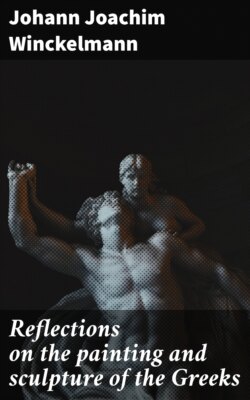Читать книгу Reflections on the painting and sculpture of the Greeks - Johann Joachim Winckelmann - Страница 11
На сайте Литреса книга снята с продажи.
VII. Allegory.
ОглавлениеTable of Contents
There is one other important step left towards the atchievement of the art: but the artist, who, boldly forsaking the common path, dares to attempt it, finds himself at once on the brink of a precipice, and starts back dismayed.
The stories of martyrs and saints, fables and metamorphoses, are almost the only objects of modern painters—repeated a thousand times, and varied almost beyond the limits of possibility, every tolerable judge grows sick at them.
The judicious artist falls asleep over a Daphne and Apollo, a Proserpine carried off by Pluto, an Europa, &c. he wishes for occasions to shew himself a poet, to produce significant images, to paint Allegory.
Painting goes beyond the senses: there is its most elevated pitch, to which the Greeks strove to raise themselves, as their writings evince. Parrhasius, like Aristides, a painter of the soul, was able to express the character even of a whole people: he painted the Athenians as mild as cruel, as fickle as steady, as brave as timid. Such a representation owes its possibility only to the allegorical method, whose images convey general ideas.
But here the artist is lost in a desart. Tongues the most savage, which are entirely destitute of abstracted ideas, containing no word whose sense could express memory, space, duration, &c. these tongues, I say, are not more destitute of general signs, than painting in our days. The painter who thinks beyond his palette longs for some learned apparatus, by whose stores he might be enabled to invest abstracted ideas with sensible and meaning images. Nothing has yet been published of this kind, to satisfy a rational being; the essays hitherto made are not considerable, and far beneath this great design. The artist himself knows best in what degree he is satisfied with Ripa’s Iconology, and the emblems of ancient nations, by Van Hooghe.
Hence the greatest artists have chosen but vulgar objects. Annibal Caracci, instead of representing in general symbols and sensible images the history of the Farnesian family, as an allegorical poet, wasted all his skill in fables known to the whole world.
Go, visit the galleries of monarchs, and the publick repositories of art, and see what difference there is between the number of allegorical, poetical, or even historical performances, and that of fables, saints, or madonnas.
Among great artists, Rubens is the most eminent, who first, like a sublime poet, dared to attempt this untrodden path. His most voluminous composition, the gallery of Luxembourg, has been communicated to the world by the hands of the best engravers.
After him the sublimest performance undertaken and finished, in that kind, is, no doubt, the cupola of the imperial library at Vienna, painted by Daniel Gran, and engraved by Sedelmayer. The Apotheosis of Hercules at Versailles, done by Le Moine, and alluding to the Cardinal Hercules de Fleury, though deemed in France the most august of compositions, is, in comparison of the learned and ingenious performance of the German artist, but a very mean and short-sighted Allegory, resembling a panegyric, the most striking beauties of which are relative to the almanack. The artist had it in his power to indulge grandeur, and his flipping the occasion is astonishing: but even allowing, that the Apotheosis of a minister was all that he ought to have decked the chief cieling of a royal palace with, we nevertheless see through his fig-leaf.
The artist would require a work, containing every image with which any abstracted idea might be poetically inverted; a work collected from all mythology, the best poets of all ages, the mysterious philosophy of different nations, the monuments of the ancients on gems, coins, utensils, &c. This magazine should be distributed into several classes, and, with proper applications to peculiar possible cases, adapted to the instruction of the artist. This would, at the same time, open a vast field for imitating the ancients, and participating of their sublimer taste.
The taste in our decorations, which, since the complaints of Vitruvius, hath changed for the worse, partly by the grotesques brought in vogue by Morto da Feltro, partly by our trifling house-painting, might also, from more intimacy with the ancients, reap the advantages of reality and common sense.
The Caricatura-carvings, and favourite shells, those chief supports of our ornaments, are full as unnatural as the candle-sticks of Vitruvius, with their little castles and palaces: how easy would it be, by the help of Allegory, to give some learned convenience to the smallest ornament!
